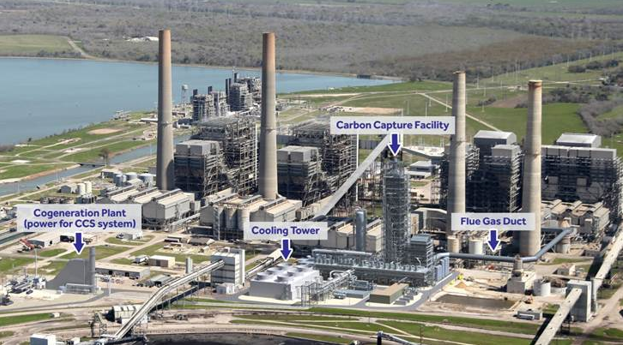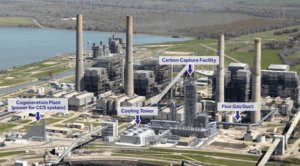
Written by Nell Cormack August 2022, edited by Katie Edwards, Robert Routh, Alex Bomstein
Supporters of hydrogen derived from fossil gas have claimed it can be a leading part of the clean energy future because of the possibility of pairing it with carbon capture and storage (CCS) technology, often referred to as carbon capture, utilization, and storage (CCUS). The fossil fuel industry advertises CCS as a way to mitigate the carbon emissions produced by burning fossil fuels to power hydrogen production.
In fact, carbon capture has been utilized by the fossil fuel industry for decades in the form of enhanced oil recovery (EOR), the process of compressing carbon dioxide to increase its density and then injecting the high-density carbon dioxide into oil reservoirs. Once injected into the reservoir, the carbon dioxide mixes with any trapped oil, which is then pumped out of the reservoir, increasing the amount of oil that can be obtained from the reservoir (and, consequently, increasing carbon emissions that result when that oil is burned). This is most commonly what companies mean when they refer to the “U” in CCUS.
While EOR has been around for quite a while, the idea of capturing carbon and storing it to reduce the impacts of climate change has only recently gained some traction among industry and governments worldwide. This idea involves capturing carbon dioxide, compressing it to a high density, transporting it, usually via pipeline, and storing it in geological formations deep underground. Carbon dioxide can be captured from emissions of industrial processes and even captured directly from the air. That direct air capture, or “carbon dioxide removal,” is in its early technological stages and is intended to be carbon negative, rather than traditional CCS which attempts to capture and reduce the amount of CO2 emitted directly from a source burning fossil fuels (making it carbon neutral, at best).
Carbon dioxide can be captured from flue gas streams with a variety of methods, but the most commonly used methods are chemical absorption, which uses a chemical solvent, and physical separation, which uses a solid surface like activated carbon to capture the carbon dioxide. After carbon dioxide has been captured, it must be transported via pipeline to a storage site.
Blue Hydrogen is Not Clean Energy
While the U.S. Department of Energy (DOE) announced in February $28 million in funding for projects involving fossil fuel-based hydrogen with CCS under the label of “clean hydrogen” (Pennsylvania will most likely seek to deploy what’s often referred to as “blue hydrogen”), it is anything but inherently clean or free from environmental risk. When carbon dioxide is transported through pipelines to storage sites, it must be transported at very low temperatures and high pressure, increasing the risk to communities and the environment surrounding the pipelines if there is a leak. A Mississippi carbon dioxide pipeline rupture in February 2020 resulted in dozens of hospitalizations and evacuations of hundreds of nearby residents. Many carbon dioxide pipelines would likely be built in marginalized communities already heavily burdened by pollution as these areas contain high concentrations of oil and gas as well as potential storage sites for carbon dioxide.
Even without the environmental risks, CCS has not proven effective at capturing carbon. As of July 2021, existing CCS facilities captured less than 1% of carbon dioxide emissions annually. Of that amount, only 19% of carbon dioxide was actually stored underground, while the remaining was used for EOR.
Additionally, hydrogen production with CCS is currently not economically viable. The Quest facility, a CCS project operated by Shell in Canada that produces hydrogen from fossil gas (sometimes referred to as “natural gas,” and which is primarily composed of methane, an extremely potent greenhouse gas), currently captures carbon at $63.70 per ton at capture rates below 85%. For capture rates above 85%, studies estimate the cost would be between $80 and $100 per ton of carbon captured. For CCS to be economically feasible, costs must be reduced to around $27 per ton by 2030, meaning cost must be reduced by over half in a few short years.
Advocates of hydrogen with CCS emphasize its potential role in hard-to-decarbonize industries like steel and cement. But in order for hydrogen with CCS to have a place in the green economy future, emphasis must be placed on increasing carbon capture efficiency while ensuring the environmental risks are minimized. If Pennsylvania becomes the site of one of the proposed regional hydrogen hubs, hydrogen would almost certainly be generated with fossil gas. The KeyState to Zero project, a proposed gas facility in Clinton County that is set to become a combined gas extraction, chemical/hydrogen production, and CCS site, expects to begin construction as early as next year. This would make it Pennsylvania’s first commercial project featuring hydrogen produced with CCS. Fossil-fuel based hydrogen is not the way to propel Pennsylvania to a cleaner, safer future. If hydrogen is to be part of the energy economy, any related lifecycle emissions must be reduced as much as possible.
Ultimately, fossil-fuel based hydrogen production with CCS runs the serious and unacceptable risk of prolonging the use of fossil fuels instead of focusing on decarbonization through the use of renewable energy sources. With blue hydrogen’s high costs, inefficiency, environmental risks, and continuation of fossil fuel reliance, investing in renewable energy sources that are becoming significantly cheaper remains the best option to reach a zero carbon future.
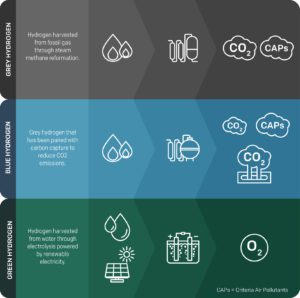
Written by Charlotte Moreno August 2022, edited by Katie Edwards, Robert Routh, Alex Bomstein
Recently, deployment of hydrogen as a fuel or energy source has become a focus for governments and industry investments both internationally (e.g., Japan, Australia, Germany) and in the US. With the global goal of net zero greenhouse gas emissions by 2050, many hypothesize that hydrogen energy will be the silver bullet to the energy transition from fossil fuels to clean energy. When burned, hydrogen does not emit greenhouse gas pollution but the different production techniques can have varying impacts as we will discuss below. The Russo-Ukrainian war has accelerated this push for clean energy to wean European and other countries off Russian oil and gas. This past June, the Biden administration publicized their intent to allocate $8 billion for the development of four regional “clean hydrogen” hubs across the country, funding which was included in the $1.2 trillion Infrastructure Investment and Jobs Act that was signed into law last November. The U.S. Department of Energy (DOE) highlights heavy-duty transportation and steel manufacturing as end-use sectors where hydrogen will assist in decarbonization. Currently companies, state and local governments, and various stakeholders are creating plans for these hubs, and DOE announced its plans to start accepting applications in September or October for funding. Given its need for industrial sector decarbonization and its substantial energy resources (particularly nuclear power and methane gas), Pennsylvania is certainly a likely region for a hydrogen hub. However, hydrogen production methods are not equal in their capacity to pollute. Knowing the differences may aid communities who face future development of hydrogen hubs in their region.
Hydrogen is the most abundant element in the universe that has potential as an energy source because of its lightweight quality and energy density. Evidence indicates that hydrogen can be used in transportation (cars, buses, trucks, airplanes, shipping), in industrial processes (steel-making, fertilizer production), and in the storage of renewable energy (to account for winter or low-wind times). The most common processes to extract hydrogen include electrolysis or steam-methane reformation which split molecules like water or methane, respectively. Hydrogen can then be pumped into a fuel cell where an electrochemical reaction occurs to create electricity. The only output is water. Developments in new processes to produce hydrogen continue to be explored.
However, we can’t talk about hydrogen without discussing the issue of how to fuel electrolysis or steam-methane reformation. Hydrogen production methods are often identified by using a color code. Methane derived from natural gas fuels the production of “gray” hydrogen through steam-methane reforming. Methane is an extremely potent climate pollutant and it leaks across all segments during its production and transportation. The process of producing hydrogen from methane also generates significant carbon dioxide pollution. Meanwhile, coal powers what’s referred to as “brown” hydrogen production, which also releases significant amounts of CO2. “Blue” hydrogen is the same as gray or brown hydrogen but adds carbon capture, utilization, and storage (CCS or CCUS), which is an effort to trap greenhouse gas emissions produced from the system and store them underground or use them to facilitate oil or gas extraction. Finally, “green” hydrogen combines renewable energy from wind or solar power with electrolysis to split hydrogen from water molecules. There are other production methods (including “pink” hydrogen produced by electrolysis via nuclear power) but the most controversial are gray, brown, and blue hydrogen because of their dependence on fossil fuels.
Not All Hydrogen is Created Equal
Clearly, not all hydrogen production methods are equal. Studies show that gray, brown, and blue hydrogen produce substantial amounts of greenhouse gas emissions. The fossil fuel industry advocates for gray, brown, and blue hydrogen because hydrogen production will continue to prop up their product and keep it marketable for years to come. Despite the benefits of burning hydrogen as a fuel source compared to fossil fuels, these production processes are anything but clean. The carbon footprint of blue hydrogen is more than 20% greater than burning methane gas or coal for heat. Additionally, 3.4% of methane, a greenhouse gas that is up to 87 times more potent than carbon dioxide at trapping heat in the atmosphere, is leaked from gas fields, storage, and transport in blue hydrogen production.
Proponents of blue hydrogen will highlight carbon capture as a way to make production cleaner. But blue hydrogen can actually be worse than gray hydrogen because more gas is required to power carbon capture, thereby producing more methane emissions. Furthermore, carbon capture projects are expensive, ineffective, and need more development. More than 80% of carbon capture projects nationwide have failed. The $1 billion project Petra Nova in Texas closed down due to mechanical problems and failure to meet carbon capture targets. In its current state of development, carbon capture cannot adequately trap target emissions from hydrogen production powered by fossil fuels. Investments in hydrogen production with low- or zero-lifecycle emissions using renewable energy are the only plausible way to combat the energy crisis effectively using hydrogen. Even so, this also involves trade-offs because we need as much renewable energy deployment as possible to generate power and clean up our electrical grid. It will be challenging to scale up the necessary amount of clean energy if we devote meaningful amounts of it to hydrogen production. Moreover, hydrogen production is incredibly energy-intensive regardless of the feedstock involved, and these energy conversions and losses mean that even green hydrogen is a much less efficient means of decarbonization when compared to, for example, direct electrification of a process using clean energy.
While there is understandable excitement for hydrogen, researchers agree that it is important to temper this enthusiasm with a realistic outlook. Hydrogen is not the one-size-fits-all fix to our energy and climate crisis and it could actually make greenhouse gas emissions worse. Hydrogen may fill a role in the energy sector, but if so, building the hydrogen infrastructure using green hydrogen or zero-emission hydrogen and targeting it to specific end-uses that otherwise cannot be electrified using clean energy will be key. Communities must keep a close eye on what the DOE and energy companies are cooking up for the hydrogen hubs which will undoubtedly shape the energy landscape for years to come.
Image credit: TANJA GEIS FOR EARTHJUSTIC, Earthjustice’s Reclaiming Hydrogen for a Renewable Future report

Volume 44, Issue 3
Started in 1981, the Fresh Air Newsletter offers the latest environmental news, local events, educational resources and programmatic updates on Clean Air Council’s work.

Chester County, PA (August 16, 2022) — Highly volatile hazardous liquids surge through the Mariner East pipeline system as it snakes through over 300 miles of Pennsylvania’s land. It passes by schools, under farms, and across streams. Existing lax regulations could not prevent Sunoco Pipeline L.P.’s reckless construction practices from creating sinkholes by homes and train tracks and contaminating residential water supplies, nor make Sunoco provide basic safety information to schools and communities in the zones threatened by potentially catastrophic leaks or explosions.
The Council, other local health and environmental groups, and impacted residents have worked tirelessly for years to protect the public and hold Sunoco accountable. We now applaud the Public Utility Commission (PUC) for stepping up with proposed common-sense rules to reduce the threat from hazardous liquid pipelines. Sunoco and other industry actors are trying to block the PUC’s proposed safety regulations, but the Council is meeting them at every turn, fighting Sunoco in court when local communities sue for relief, amplifying the voices of the public, and supporting the PUC’s invaluable efforts.
One of the most important proposed regulations would help prevent sinkholes and potential pipeline ruptures by requiring pipeline builders to look at the geology of a site before starting construction. Pennsylvania’s unique geology includes unstable limestone formations, called karst. These pipelines carry volatile gasses that are compressed under great pressure into liquid. If the pipelines rupture, heavier-than-air gasses would rapidly blanket the surrounding area, potentially suffocating anyone in range, and the slightest spark could ignite the highly flammable gasses. So, it seems obvious to avoid building where the ground might crumble away, leaving the pipeline unsupported. Yet Sunoco historically neglected to adequately check its construction sites, too often with disastrous results, and now fights this necessary rule.
The PUC also wants to require pipeline operators to provide local officials and emergency responders with the information they need to protect their communities in the event of an accident. The Council strongly supports providing all the information needed to local officials charged with protecting schools in the potential impact zone of a pipeline leak or other accidents. Previously, Sunoco provided such limited information to local community members that it left them quite unprepared for a pipeline disaster. For instance, the company left residents confused about when they should call “911” because a cell phone might produce a catastrophic spark.
The Legal Exposition
Buckle in for some legal exposition identifying what has happened and what still needs to happen before PUC’s proposed safety rules start protecting Pennsylvanians. Administrative regulations like these must go through several steps before being finalized, including opportunity for the public to submit comments. Here, the PUC decided to also invite a second round of comments to allow members of the public to respond to each others’ initial remarks. The rulemaking attracted comments from a wide range of interested parties, ranging from residents to local government officials to the American Petroleum Institute (the national trade association for the fossil fuel industry), and, of course, Sunoco.
In addition to raising public awareness during this process, the Council led a coalition of other knowledgeable public advocacy groups in drafting comments which (1) supported the PUC’s authority; (2) suggested ways to strengthen the proposed rules, including grounding the regulations in well established industry “best practices” which are too often ignored; and (3) bolstered the voices of local communities. In the second round, our coalition refuted the many baseless objections raised by Sunoco and their allies and provided further support for the concerns of local governments and nearby residents.
The comments and the proposed rules were then reviewed by Pennsylvania’s Independent Regulatory Review Commission (IRCC), as is standard. IRCC then prepared its own comments, referencing public comments and asking the PUC to conduct additional analysis.
What are the next steps
PUC must consider and publish a response to all of the comments before drafting a final form of the rules which it needs to send back to the IRCC. The PUC has two years from when the public comment period closed to complete the process, which makes the deadline May 12, 2024. IRCC will then discuss the rules at a public hearing and vote on whether the rules are “in the public interest.”
In the meantime, Clean Air Council will be part of the bulwark protecting the communities that brought successful challenges to some Sunoco’s harmful practices. Sunoco’s legal challenges to the PUC’s orders that resulted, combined with their public comments to the rulemaking, foreshadow their likely future judicial challenges to the safety rules. For instance, Pennsylvania law charges the PUC with ensuring that public utilities are operated safely and efficiently, making “every reasonable effort to warn and protect the public” from potential dangers. Sunoco argued strenuously for public utility status for its hazardous liquid pipelines because that allowed it to use the power of eminent domain to condemn private property to build its pipelines. Now it argues in public comments and in court that it should not need to accept the associated responsibilities. Astoundingly, in fighting these regulations Sunoco is essentially claiming that, in the event of a Sunoco-created pipeline emergency, it would be an unreasonable effort for Sunoco to 1) warn the officials in charge of keeping nearby school children safe, and 2) provide basic information public officials need to develop emergency-response plans to protect the children and others.
Clean Air Council will not let such claims stand. The Council will continue to fight Sunoco’s obstructionist, irresponsible behavior in court and through the regulatory process. It looks forward to reporting when the PUC’s new regulations are finalized and begin making Pennsylvania safer.
For more information, contact Annie Fox, Law Clerk at afox@cleanair.org.

- Where are you from and what’s your background?
I grew up in Bozeman, Montana and Baltimore, Maryland, so I got the best of both worlds in a sense. I went to Temple University for my Bachelors in Advertising with an Art Direction concentration. After I graduated, I interned for Global Philadelphia Association and worked on their Sustainable Development Goals Public Art Project, that brings the 17 SDGs to life through murals around Philadelphia, as the designer, and then, worked for the World Trade Center of Greater Philadelphia as their Digital and Design Coordinator.
- How long have you been with the Council?
I have been at the Council for a little over 5 months now.
- Why did you choose to come work for the Council?
I’ve always been passionate about making a difference and working with people/communities, so coming to work for the Council seemed like the perfect place where I could expand and use my skills while fighting the good fight and helping communities.
- What’s your expertise you bring to the Council? How do you use it to fight for a cleaner environment?
I am a graphic designer, communicator, storyteller, and videographer. I use my skills to help amplify the voices of community members, provide information in a creative way, and reshape the climate crisis in a way that is understandable for everyone.
- How can others use their social media to promote climate action?
The best thing that you can do through social media is to promote climate action by talking about it. Share actions, information, resources, quotes, etc., but include it in your discourse on social media. If we don’t talk about the climate crisis and how it is affecting us, it’ll continue to go under the radar and not be seen as an emergency. This could look like sharing how nature has changed around you over the years, if you’re experiencing climate anxiety and what that feels/looks like, what your hopes for the situation/our society are, how you take action, how it will affect you, etc. This is a heavy, existential topic, but it is so important we begin to bring it into casual and online discourse on social media.
6. What’s the biggest challenge to getting people offline and taking action in the real world?
People seem to think posting an infographic, resource, or quote is enough when it’s just one part of what you can do to fight the climate crisis. The biggest thing one can do is taking the energy you’re putting online offline and bring it into your life. One way I do this is setting a goal each week of something I want to do to take action. It could be anything from not eating meat, walking and biking more to get around, buying produce/groceries locally, not ordering takeout, reading/learning something new about the climate crisis, etc. Start with something small and attainable then work up to a bigger challenge. Remember, the fossil fuel industry wants you to believe that this is your responsibility and it’s too big to solve. It is not your sole responsibility; however, there are things we can all do to alleviate the situation. Earth Hero, an app to fight climate change, is a great tool for different action items and a way to track and cut your emissions.
7. Besides following the @CleanAirCouncil social accounts, who are some other groups or environmental activists you like and follow?
PennFuture (@pennfuture), Climate Action PA (@climateactionpa), GASP (@gasppgh), PennEnvironment (@pennenvironment), FracTracker (@fractracker), Sunrise Movement PA (@sunrisemovementpa), and the Green Party of Pennsylvania (@pagreenparty) are all great accounts to follow for local and state wide climate initiatives, activism, stories, and actions.
EarthJustice (@earthjustice), Sierra Club (@sierraclub), Future Earth (@futureearth), Fridays For Future (@fridaysforfutureusa), Sunrise Movement (@sunrisemovement), and Extinction Rebellion (@extinctionrebellion) are all good accounts to follow for national climate updates.
Kendra Pierre-Louis, Peter Kalmus, Vic Barrett, Xiye Bastida, Dr. Jonathan Foley, Alaina Wood, Dr, Katherine Hayhoe, Dr. Genevieve Guenther, and Dr. Katherine Wilkinson are all activists and climate scientists that are doing great work and sounding the alarm.

- Where are you from and what’s your background?
I was born in Northeast Philadelphia and grew up between there and lower Bucks County. I went to college at Georgetown University in Washington, D.C., and after a year working on Capitol Hill, I went to law school at Duke University.
I began my legal career working at a large international law firm, Ropes & Gray, for four years. I then joined the Council as a legal fellow from 2016-2017. I left to clerk at the U.S. Court of Appeals for the Third Circuit for four years before finding my way back to the Council this past fall.
- How long have you been with the Council?
One year in 2016-17, plus 9 months since rejoining in October 2021.
- What’s your expertise you bring to the Council? How do you use it to fight for a cleaner environment?
My expertise is in litigation. In more practical terms, I think of myself as a legal communicator, which looks more like being a writer, teacher, counselor, and/or advocate, depending on the situation. I primarily write legal briefs, which (at their best) educate the court and advocate for a just interpretation of the law that protects the environment. I also enjoy counseling our organization and communities regarding their environmental rights and possible legal actions to protect them.
- Why did you want to return to working for the Council after being a legal fellow in 2016-2017? What’s your favorite aspect of working here?
Everyone at the Council is here because they are deeply committed to a cause that is larger than themselves. The team shows up every day willing to make sacrifices to do this work. It’s inspiring and energizing to be around a group of people who keep at it despite the challenges and headwinds we often face.
Also, I think too few Pennsylvanians know that they have a state constitutional right to a healthy environment. The Pennsylvania Supreme Court reinvigorated that right in 2017, when I was working for the Council as a legal fellow. I was excited to come back and continue the work of ensuring that our courts appropriately interpret and protect that right, which I hope might serve as a national model one day.
- What are you working on?
I am primarily working on the defense of Pennsylvania’s participation in the Regional Greenhouse Gas Initiative (RGGI), and on opposition to the zoning for a quarry in Upper Bucks County. I have also been working on an appeal to ensure that polluters pay their fair share of the legal costs when they violate environmental laws.
- What legal battles or challenges are you following closely in Pennsylvania?
The Pennsylvania Environmental Rights Amendment is being litigated in a lot of cases that I am following closely, including the cases I noted above that I am working on. This includes the RGGI litigation. RGGI is a cap-and-invest program that is arguably the state’s most significant action ever (though we still need to do more) to address climate change, and I’m hopeful our courts will not stand in the way of its implementation.

This summer the Clean Air Council is celebrating Executive Director and Chief Counsel, Joseph Minott’s 40 years of leading the Clean Air Council! It is rare to have such strong and stable leadership like what Joe has provided for almost his entire career.
Joe is a sought after environmental voice and leader across the state and the region. He has spent his career championing environmental issues like clean air and water, advocating for a transition away from fossil fuels, and promoting clean energy solutions such as energy efficiency, wind, solar and geothermal.
Being an environmental activist in a fossil fuel state is not for the faint of heart.
Joe started as a new Staff Attorney in 1982 and within 3 years, was appointed as Executive Director and Chief Counsel, and he still fills those roles today. Joe fought tirelessly to raise awareness on urban air pollution in the1980’s by establishing and distributing a daily regional air quality index report that is still used today.
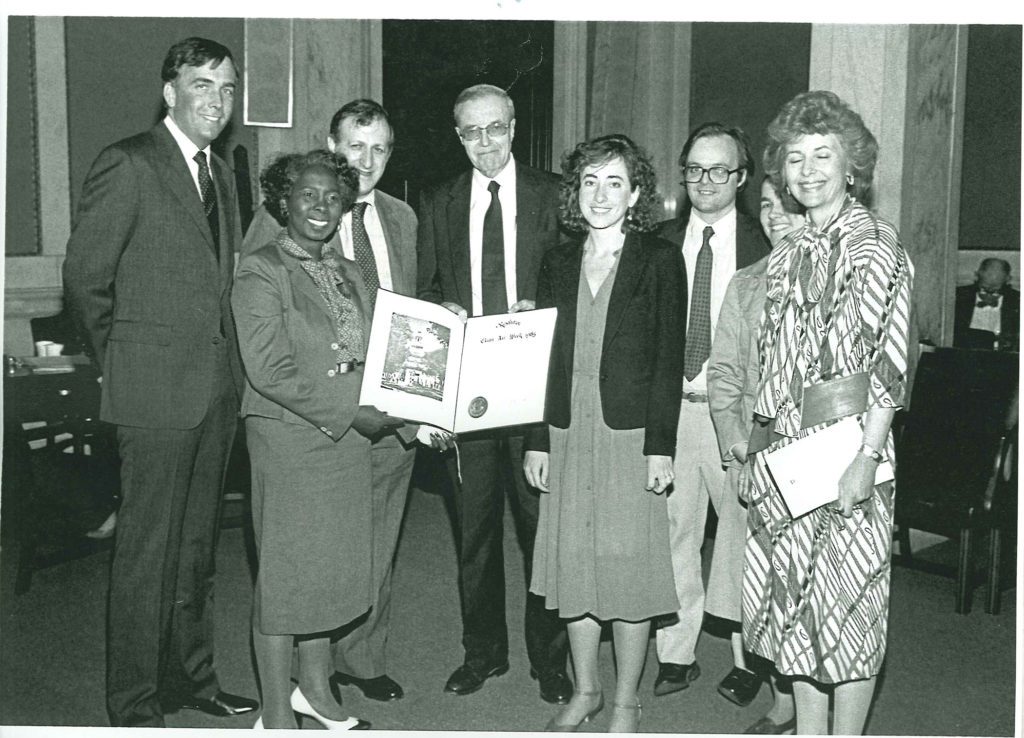
And in the early 2000’s when fracking was falsely seen as transitional energy, Joe purposely grew the legal team to oppose natural gas expansion. He also increased the Council’s community organizers to warn residents about the harms of the fracking industry. Joe hired engineers and public health educators on staff, successfully giving the Council more credibility with the public, and in the courtroom. Working for the Council, Joe and his legal team have sued the federal government, the state government, local governments, and the fossil fuel industry.
Joe has over 40 years of community organizing experience, and he served on the PA Department of Environmental Protection’s Air Quality Technical Advisory Committee and its Environmental Justice Advisory Committee, and the City of Philadelphia’s Air Pollution Control Board.
Under Joe’s leadership, the Council has grown considerably in depth and breadth, now enjoying a $3 million budget and a staff of over 30 environmental experts. Joe’s greatest accomplishments include the drafting of Philadelphia’s mandatory recycling law, forcing the Commonwealth to implement an automobile emissions inspection program, securing funding for, and helping to form, Community Energy, Inc., (a successful, local renewable energy company), and promoting the development of off-shore wind in the State of Delaware.
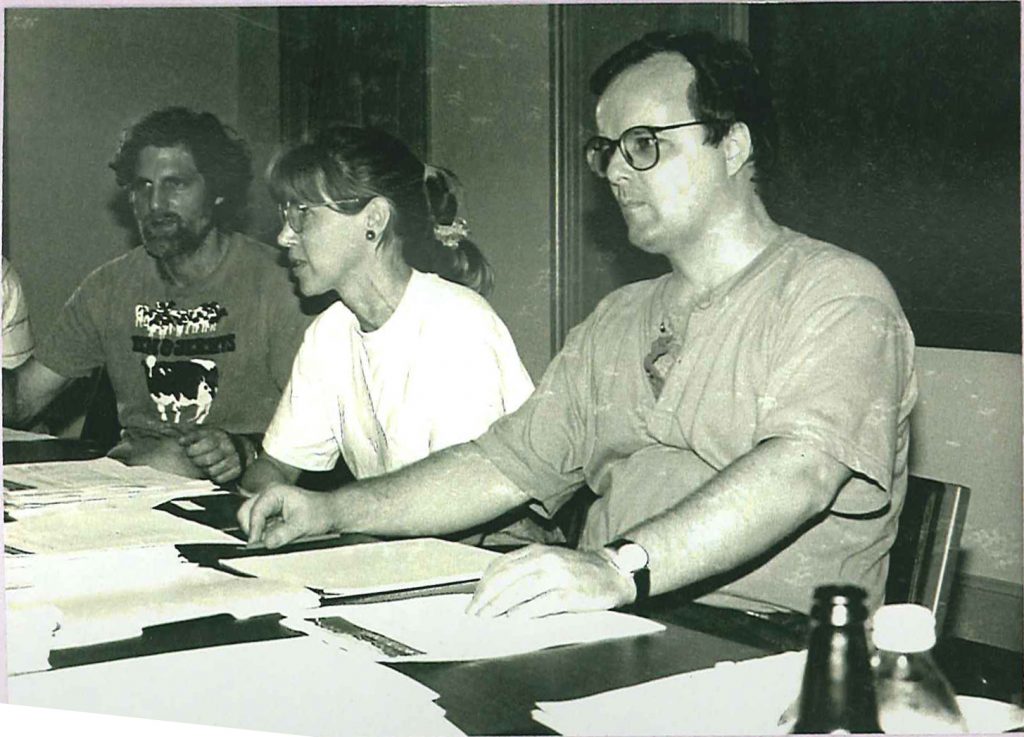
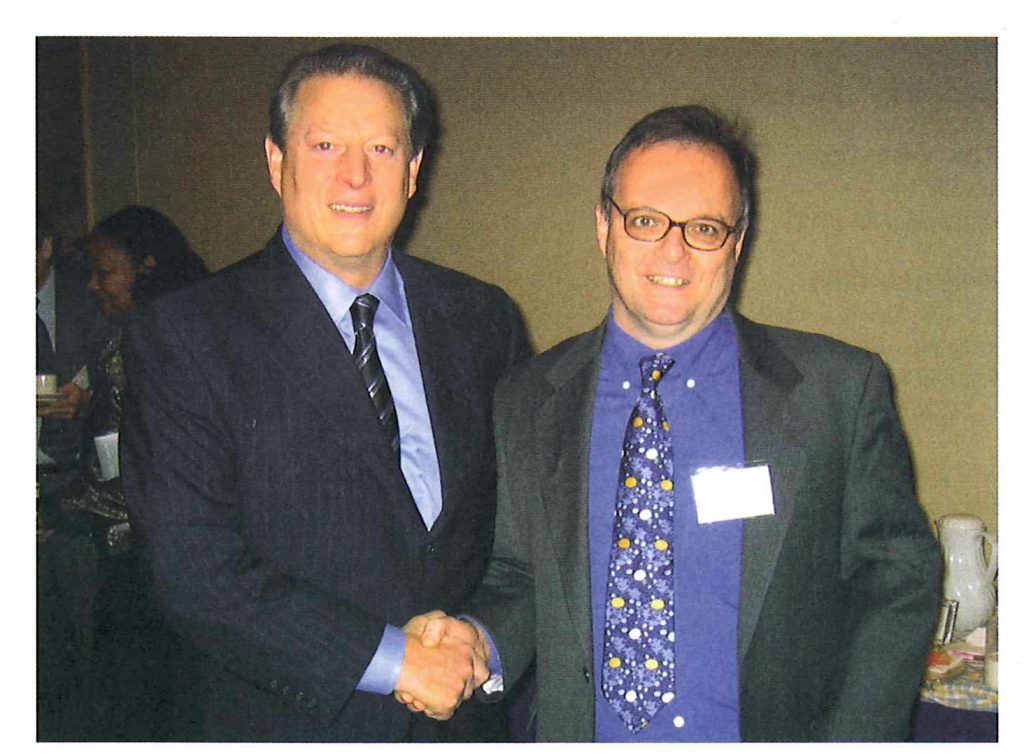
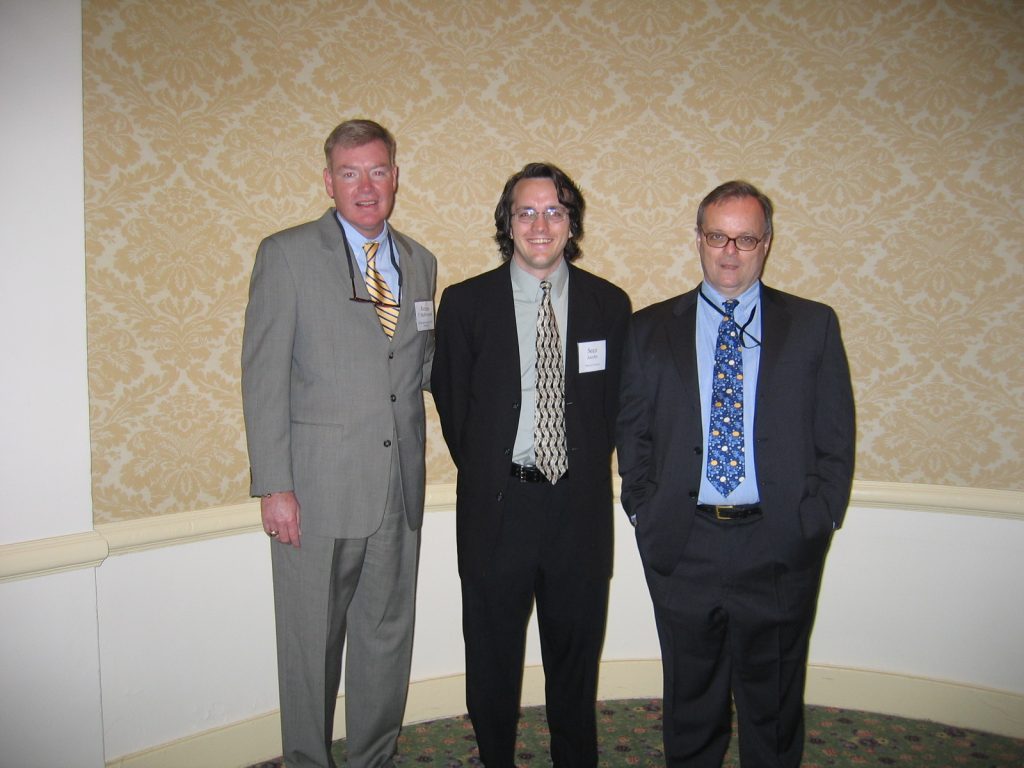

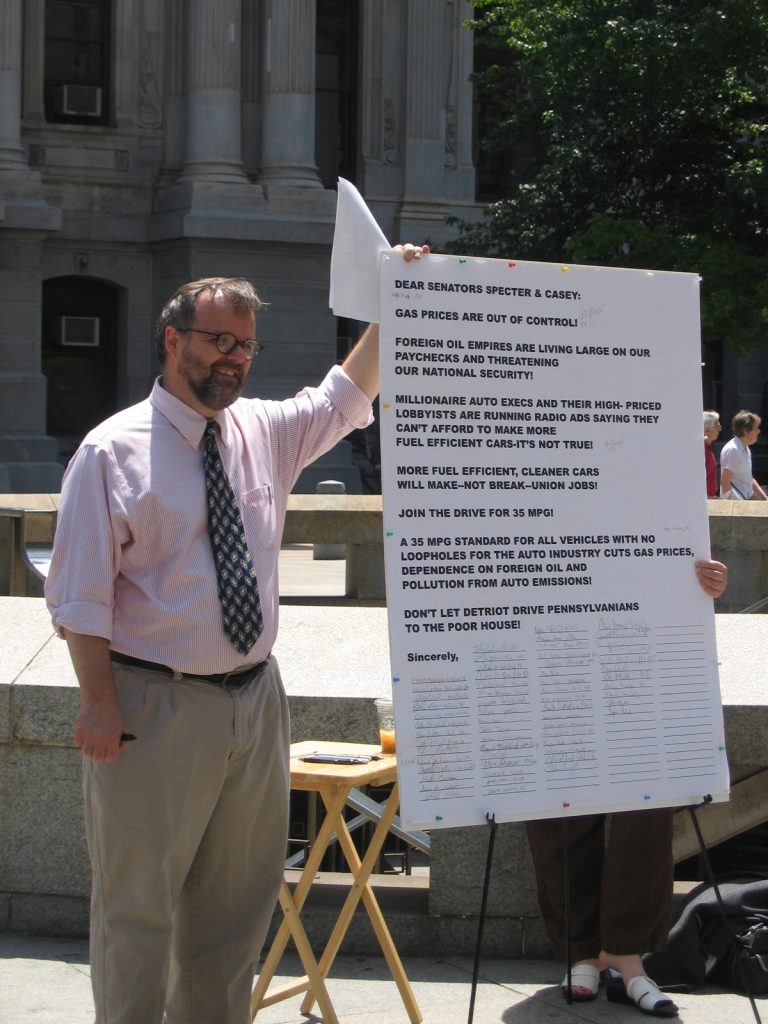

In 2020, amidst changes in state politics, Joe saw the need for more direct engagement in elections and politics in Pennsylvania, so he led the creation of the Council’s 501c4 sister agency called the Clean Air Action Fund – to help maximize environmental impact by allowing for greater activism directly with candidates and elected officials.
Today, Joe leads the Council in defending PA’s effort to join the Regional Greenhouse Gas Initiative (RGGI), a multi-state movement to lower emissions from the power plant sector. RGGI is a huge win for climate action, but the coal industry and politicians in Harrisburg have gone to court to block Pennsylvania from moving forward with RGGI. Part of Joe’s environmental legacy will be to make sure RGGI crosses the finish line, and that the resulting revenues are invested in clean energy.
Joe has decided that any donations will go toward hiring a Legal Fellow in 2023 to assist the legal team with ongoing litigation, like fighting Mariner East II pipeline, and other proposed natural gas projects such as the Shell Petrochemical Plant. The legal work is one avenue where the Council makes its greatest impact, and currently, there is no funding for the Legal Fellow position for 2023.
Make a gift to honor Joe’s 40 years of protecting the environment.
Your tax-deductible special gift will go a long way toward strengthening the Council’s legal team and ensuring the Council can hire a Legal Fellow for $60,000 in 2023.

VOLUME 44, ISSUE 2
Started in 1981, the Fresh Air Newsletter offers the latest environmental news, local events, educational resources and programmatic updates on Clean Air Council’s work.

Philadelphia, PA (May 19, 2022)
- Where are you from and what’s your background?
I’m a local! I’m a biracial Korean American and grew up in Northeast Philly. I’ve lived and been an organizer in the Philly area for most of my life.
- When did you start on staff for the Council?
I started at the end of November 2021.
- Why did you choose to come work for the Council?
I had known about the Council for some time before I came to work here so I was very excited when I saw the opportunity was available. I was drawn to the Council because we’re unequivocal about where we stand on fossil fuels and their development in Pennsylvania, which is a hard fight in this state considering the power of the industry but that makes it more important in my opinion, especially in the fight for climate justice. Pennsylvania is the second-highest gas producing state in the country, our fight here matters for the rest of the world and that’s something I’ve always wanted to be a part of.
- What are you organizing around right now?
A lot! I’m working with a coalition to get President Biden to ban the transport of liquified natural gas (LNG) by rail. I’m working with a coalition of community groups to oppose a gas to liquid gasoline plant that a Texas company called Nacero wants to build in Luzerne County. A Chicago-based company called Invenergy wants to build a gas plant in Western Pennsylvania. Depending on where each project is, this can involve background research or, for example, I presented on a community forum about the air pollution impacts from a proposed refinery.
- What’s your expertise you bring to the Council? How do you use it to fight for a cleaner environment?
I have a unique mix of policy and organizing experience. I have a Master’s in Public Policy and wrote my graduate thesis as a case study on the fossil gas industry’s influence on state agencies and government. Basically, I looked at how the industry influences every level of state government and takes over agencies such as DEP. The industry relies on information being hard to access or too technical to understand. I’m able (and like it as a policy nerd!) to get into the weeds on a policy level and demystify the process and present information in a more accessible way for broader audiences.
- What’s the most promising change(s) you’ve seen in the environmental movement recently?
I’m glad to see environmental racism being named and talked about in the mainstream movement. For so long, “environmental justice” felt like a checkbox on a to-do list without any interrogation of the history and real policy choices that create these structural inequalities, including the role of the environmental movement itself in creating and perpetuating those inequalities. I’m also inspired by local change like people building their own networks and resources, even something small like a container garden on their porch or in their yard. People also talk a lot about despair but the movement is also full of hope, determination, and imagination about fighting for a better world and that continually inspires me.
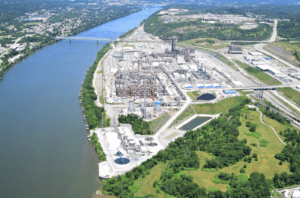
Pittsburgh, PA (May 18, 2022) By late 2022 or early 2023, Shell’s Beaver County ethane cracker plant will be turning fracked gas into 1.6 million metric tons of plastic pellets per year. The facility was originally planned as the anchor for a vast “Petrochemical Hub” of four more crackers strewn across the Ohio River Valley. Each cracker plant would increase climate and plastic pollution and worsen air quality locally, all at the cost of residents’ health. At this point, plans for a second ethane cracker in Belmont County, Ohio, are on hold.
A decade ago when planning began, Executive Director Joe Minott first spoke out against Shell’s plant in a Beaver County Times opinion piece, and in 2014, the Council released a vital educational resource for residents’ protection: A 76-page Health Impacts Assessment of the petrochemical plant. In 2016, the Council shared with many residents a factsheet showing that, according to its permit, the plant would release up to 159 tons of fine particulate matter and 522 tons of volatile organic compounds (VOCs) annually. In 2018, the Council and Environmental Integrity Project won their two-year legal battle for flaring limits and a fenceline air monitoring system that will detect air pollution that travels outside the site boundary, and then make needed repairs. The Council was also successful in convincing Potter Township to include in its municipal permit for the plant better quality-of-life protections from lighting, noise, and traffic.
Still, this is not enough. The Council is now calling on Shell to live up to its claim of being a “good neighbor” by doing more to protect residents and the environment from pollution than what is legally required.
The Council is encouraging Beaver County and Southwest Pennsylvania residents to insist that Shell take the following actions:
1) For all non-routine incidents or emergency events such as flarings, spills or discharges, notify residents within a three-mile radius of the plant in real time. Promptly follow up with fully transparent, public reports on potential threats to health, safety or the environment. Issue fully transparent and timely public reports on how spills were disposed of, as well as any causal explanations and remedial actions taken.
2) For any accidental release into the Ohio River, notify in real time the nearby Center Township Water Authority in Beaver County, as well as across-the-river municipalities like Vanport and Midland with intakes near the plant’s outflows. Notify also the Pennsylvania Fish and Boat Commission and all downstream residents.
3) For any plant accident that poses a health, safety or environmental threat, notify in real time Beaver County’s Local Emergency Planning Committee (LEPC) and nearby municipal police departments.
Note: None of the above notifications were provided for the March 19, 2022 accident in which 2,500 gallons of sulfuric acid were spilled at the plant.
4) In order to quickly repair any leaks of organic compounds, use infrared cameras to detect leaks faster than required under the permits, or use infrared cameras for continuous or automated leak detection, since they would catch a leak faster than an inspection or possibly even the fenceline system.
5) Provide residents with a list of:
- Standard Operating Procedures (SOPs) for basic plant operations, such as those that might apply to sulfuric acid spills, ethane releases or coke fires.
- All emergency-response provisions.
6) Satisfactorily complete the commissioning-period “Exterior Lighting Study” as required by Potter Township’s Resolution No. 3-2017. This requirement was a result of the Council’s advocacy in following up with Potter Township to ensure it would require Shell to complete a post-construction lighting study, which is now underway. The study’s results, which cannot be publicly shared until December 2022, should answer the Council’s questions about whether the plant’s LED lights meet the recommendations of the International Dark Sky Association (darksky.org).
7) Publicly acknowledge and disclose information about the number of new frack wells it will take to supply ethane for feedstock to the plant, and over what time periods. Estimates are that the plant will require 1,000 new wells every 3 to 5 years. In addition, provide the number of compressor stations, pipelines, processing plants, injection wells and other infrastructure it will take to process ethane at the plant. Provide and disclose an analysis of the cumulative health risks and greenhouse gas contributions of all of this infrastructure.
8) Act boldly, given Shell’s support of the Paris agreement, to
- Publicly acknowledge the contribution of the plant and its supporting petrochemical buildout to climate change.
- Update the plant’s emission controls to proportionately reduce its greenhouse-gas emissions – or, at the very least, purchase offsets to account for these emissions.
- Refuse to invest in and waste resources on false climate solutions like carbon capture and storage.
For the sake of the residents onto whom it has externalized so many costs, Shell should honor each of these eight wishes. As the world’s 19th richest corporation, it can afford to honor them all.
For more information, contact Terrie Baumgardner, Outreach Coordinator and Beaver County resident, at tbaumgardner@cleanair.org.
Want to get involved? If you live in Beaver County or in the river-valley emissions corridor into Pittsburgh, start by googling “Eyes on Shell Watchdog Team.” If you live anywhere in Pennsylvania, urge your elected officials to support the Council’s Protective Buffers campaign for state-mandated setbacks we should have had long ago: Science-based buffers between all homes, school, and hospitals and the nine types of fracking infrastructure – including cracker plants.
